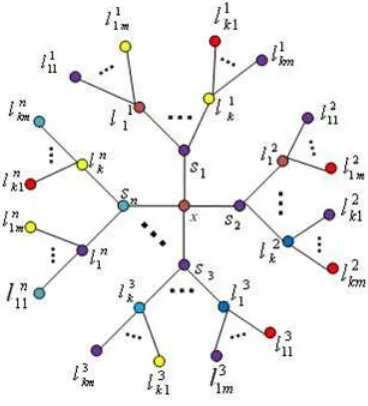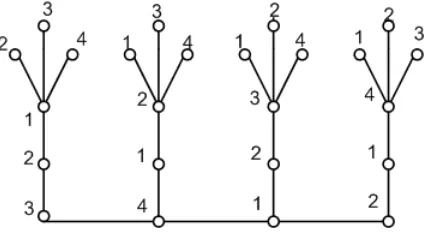THE LOCATING-CHROMATIC NUMBER FOR
CERTAIN OF TREES
Asmiati
Abstract. The locating-chromatic number is an interesting study until now, par-ticularly in tree. In this article, we will discuss the locating-chromatic number for some certain of trees.
1. INTRODUCTION
The locating-chromatic number of a graph was firstly studied by Char-trand et al. [7] in 2002. This concept is derived from graph coloring and partition dimension [9].
We use a simple graph G= (V, E) and connected. Let c be a proper coloring using k colors, namely 1,2, . . . , k. Let Π = {S1, S2,· · · , Sk} be a partition of V(G), induced by c and Si is the color classes received the color i. The color code, cΠ(v) = (d(v, S1), d(v, S2), . . . , d(v, Sk)), where
d(v, Si) = min{d(v, x)|x ∈ Si} for i ∈ [1, k]. If all vertices in V(G) have different color codes, then c is called a locating-chromatic k-coloring of G. Minimumksuch thatGhas a locating coloring called the locating-chromatic number, denoted by χL(G). A vertex u ∈ Si, for some i, is dominant if
d(v, Sj) = 1 for j 6=i.
Study on the locating-chromatic number is still challenging to date because there is no formula to determine the locating-chromatic number
Received 04-12-2016, Accepted 11-12-2016.
2010 Mathematics Subject Classification: 05C12, 05C15
Key words and Phrases: Locating-chromatic number, Tree.
of tree in general. Chartrand et al. [7] discussed the locating-chromatic numbers paths, caterpillars, cycles, stars, double stars, and complete mul-tipartite graphs. Next, Asmiati et al. [1] studied the locating-chromatic number for amalgamation of stars, non homogeneous amalgamation of stars [4], and The locating-chromatic number of firecracker graphs [2], whereas Baskoro and Purwasih [6] for corona product of graphs.
In Characterizing locating-chromatic number of a graph, Chartrandet al. [8] determined characterizing graph with locating-chromatic number n,
n−1, or n−2. Asmiati and Baskoro [3] characterized graphs containing cycle with locating-chromatic number three and Baskoroet al. [5] found all trees having locating-chromatic number three.
2. THE LOCATING-CHROMATIC NUMBER OF GRAPH nTk,m
First, we will discuss about the locating -chromatic number of graph
nTk,m, but before will be given construction of graphnTk,mas shown below.
Figure 1: Construction of nTk,m.
Proof. We shall determine the lower bound of graph nTk,m, for m ≥ k
integer and k ≥ 2. Observe that each vertex li
j, j ∈ [1, k] and i ∈ [1, n] adjacent tomleaves whose the same distance to other vertices. So, at least we needm+1-locating coloring of graphnTk,m, form≥kinteger andk≥2.
Next, We determine the upper bound of graphnTk,m, form≥kinteger and
k≥2. Consider the (m+ 1)-coloringconnTk,m. Without loss of generality, we assign c(x) = 1 and si, for i∈ [1, n] is colored by 2,3, . . . ,⌊mk+1⌋. The vertices lji,c(lij) ={1,2, . . . , m+ 1}\{c(si)}, for j∈[1, k] andi∈[1, n]. To make sure that the leaves will have distinct color code, we assign combination of c(li
jt) ={1,2, . . . , m+ 1}\{c(lij)}, forj∈[1, k],i∈[1, n], andt∈[1, m]. We show that the color codes for all vertices in nTk,m, for m ≥ k integer and k≥2, are different.
• If c(x) =c(lji), then cΠ(x) contains ⌊mk+1⌋ components have value 1,
whereas cΠ(lij) contains m components have value 1. We know that
⌊m+1
k ⌋< m. So,cΠ(x)6=cΠ(l i jt).
• Considerc(si) =m. Ifc(x) =c(ljti ), thenmth-component incΠ(x) has value 1, whereas in cΠ(lijt) has value 2. As a result, cΠ(x)6=cΠ(ljti ).
• If c(sr) =c(lji), where r 6=i, then lij must be a dominant vertex, but
sr is not. So,cΠ(sr)6=cΠ(lji).
• If c(sr) = c(lijt), then cΠ(sr) contains at least two components have value 1, whereas cΠ(ljti ) contains exactly one component has value 1. So,cΠ(kr)6=cΠ(lijt).
• Ifc(lijt) =c(lrpq ), thencΠ(lijt)6=cΠ(l q
rp), sincec(lpr)6=c(lij).
• Ifc(lni) =c(ljtm), thencΠ(lin) contains exactlymcomponents have value 1, whereas cΠ(lmjt) contains exactly one component has value 1. So,
cΠ(lin)6=cΠ(lmjt).
From all above cases, We see that the color code for each vertex in nTk,m is unique, then c is a locating-coloring. Therefore,χL(nTk,m) ≤m+ 1, for
3. THE LOCATING-CHROMATIC NUMBER OF F∗ n,k
A firecracker graph Fn,k, namely the graph obtained by the concate-nation of n stars Sk by linking one leaf from each star [2]. Let V(Fn,k) =
First, we determine the lower bound of F∗
The coloring cwill create a partition Π on V(F∗
n,4). We shall show that all
vertices in F∗
n,4 have different color codes. We have cΠ(xi) = (2,1,0, i+ 2)
for odd iand cΠ(xi) = (1,0,1, i+ 2) for even i. For y1, cΠ(y1) = (3,0,1,2)
and fori≥2cΠ(yi) = (3,0,1, i+3) for oddi,cΠ(yi) = (0,1,2, i+3) for even
i. Next, we havecΠ(mi) = (1,1,0, i+4) for oddiandcΠ(mi) = (1,0,1, i+4)
for even i. For vertices li,j, cΠ(l11) = (5,2,1,0) and cΠ(l12) = (5,0,1,2).
For i ≥ 2, cΠ(li1) = (0,1,2, i+ 5), cΠ(lij) = (0,2,1, i+ 5) for odd i and
cΠ(lij) = (2,1,0, i+ 5) for even i. Since all vertices in Fn,∗4 have different
color codes, thus cis a locating-chromatic coloring. So χL(F∗
n,4)≤4.
Next, we show that fork≥5, χL(Fn,k∗ ) =kifn≥k, and χL(Fn,k∗ ) =k−1 if 1≤n≤k−1. To show this, we divide two cases.
Case 1. Fork≥5 and 1≤n≤k−1.
Since each vertexliis adjacent to (k−2) leaves, clearly thatχL(Fn,k∗ )≥
k−1 for k≥5 and 1≤n≤k−1. Next, Define a (k−1)-coloring c of F∗
n,k, as follows. Assign c(mi) =i, for
i∈[1, n]. Leaves,{lij|j ∈[1, k−2] by{1,2, . . . , k−1}\{i}, for anyi. Next,
c(yi) = 2, for oddi and 1 for even i. c(xi) 6=c(mi) for i∈[1, k−1]. As a result, coloringcwill create a partition Π ={U1, U2,· · · , Uk−1}on V(Fn,k∗ ), whereUi is the set of the vertices by colori.
We show that all vertices in F∗
n,k for k ≥5, n≤k−1 have different color codes. Letu, v∈V(Fn,k) andc(u) =c(v). Then, for somei, j, h, landi6=j consider the following cases.
• Ifu=lih, v=ljl, thencΠ(u)=6 cΠ(v) since d(u, Ui)6=d(v, Ui).
• If u = lih, v = yj, then cΠ(u) contains exactly one component have
value 1, whereascΠ(v) contains at least two components have value 1.
So,cΠ(u)6=cΠ(v).
• If u = lih, v = xj, then cΠ(u) contains exactly one component have
value 1, whereascΠ(v) contains at least two components have value 1.
So,cΠ(u)6=cΠ(v).
• If u = mi, v = xj, then u must be a dominant vertex but v is not. Thus,cΠ(u)6=cΠ(v).
• Ifu=xi andv=xj, thencΠ(u)6=cΠ(v) since c(mi)6=c(mj).
From all above cases, we see that all vertices in F∗
n,k for k ≥5, n ≤k−1 have different color codes, thusχL(F∗
n,k)≤k−1.
For an illustration, we give the locating-chromatic coloring ofF∗
4,5 in Figure
2.
Figure 2: A locating-chromatic coloring ofF∗
4,5.
Case 2. Fork≥5 and n≥k.
We determine the lower bound fork≥5 andn≥k. It is clearly that
χL(Fn,k∗ ) ≥ k−1. For a contradiction assume we have a (k−1)-locating coloring c on F∗
n,k for k ≥ 5 and n ≥ k. Since n ≥ k, then there are two
i, j,i6=j, such that{c(lit)|t= 1,2,· · · , k−2}={c(ljl)|l= 1,2,· · ·, k−2}. Therefore the color codes of mi and mj are the same, a contradiction. So, we have χL(F∗
n,k)≥k−1, forn≥k.
Next, we determine the upper bound of F∗
n,k for k ≥ 5, n ≥ k. To show that F∗
n,k ≤kfork≥5 andn≥k, consider the locating-coloringcon
F∗
n,k as follows:
• c(xi) = 1 if iis odd andc(xi) = 3 if iis even;
• c(mi) = 2 for everyi;
• c(yi) = 2 for everyi;
• IfB ={1,2, . . . , k}, define:
{c(lij)|j= 1,2, . . . , k−2)}=
It is easy to verify that all vertices have different color codes. Therefore, c
is a locating-chromatic coloring on F∗
n,k, and so χL(Fn,k∗ ) ≤ k, for n ≥ k. This completes the proof.
REFERENCES
1. Asmiati, H. Assiyatun, E.T. Baskoro, Locating-Chromatic Number of Amalgamation of Stars, ITB J.Sci. 43A (2011), 1-8.
2. Asmiati, H. Assiyatun, E.T. Baskoro, D. Suprijanto, R. Simanjuntak, S. Uttunggadewa, Locating-Chromatic Number of Firecracker Graphs, Far East Journal of Mathematical Sciences 63(1) (2012), 11-23.
3. Asmiati, E.T. Baskoro, Characterizing of Graphs Containing Cycle with Locating-Chromatic Number Three, AIP Conf. Proc. 1450 (2012), 351-357.
4. Asmiati, Locating-Chromatic Number of Non Homogeneous Amalgama-tion of Stars, Far East Journal of Mathematical Sciences 93(1) (2014), 89-96.
5. E.T. Baskoro, Asmiati, Characterizing all Trees with Locating-Chromatic Number 3, Electronic Journal of Graph Theory and Applications 1(2) (2013), 109-117.
6. E.T. Baskoro, I. A. Purwasih, The Locating-Chromatic Number for Corona Product of Graphs,Southeast-Asian J. of Sciences1(1) (2012), 126-136. 7. G. Chartrand, D. Erwin, M.A. Henning, P.J. Slater, P. Zang , The
Locating-Chromatic Number of a Graph, Bulls. Inst. Combin. Appl. 36 (2002), 89-101.
8. G. Chartrand, D. Erwin, M.A. Henning, P.J. Slater, P. Zang , Graph of Order n with Locating-Chromatic Number n−1, Discrete Mathematics
269 (2003), 65-79.
9. G. Chartrand, P. Zhang, E. Salehi, On the Partition Dimension of Graph,
Congr. Numer. 130 (1998), 157-168.
Asmiati: Department of Mathematics, Faculty of Mathematics and Natural

